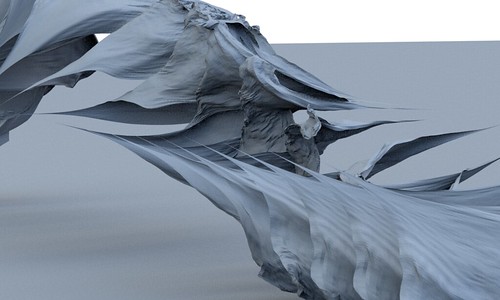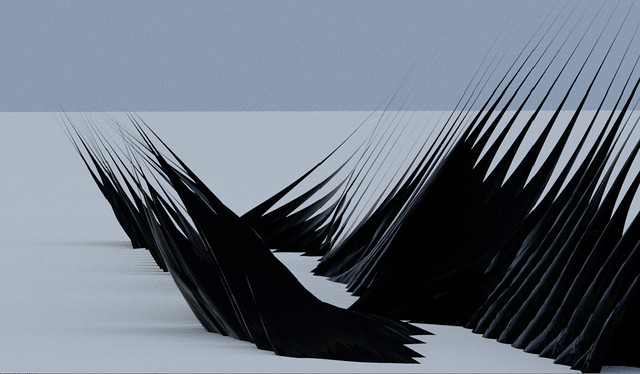Desire Path
A desire path is a path developed by erosion caused by footfall. The path usually represents the shortest or most easily navigated route between an origin and destination. The width and amount of erosion of the line represents the amount of demand. Desire paths can usually be found as short cuts where constructed pathways take a circuitous route.
They are manifested on the surface of the earth in certain cases, e.g., as dirt pathways created by people walking through a field, when the original movement by individuals helps clear a path, thereby encouraging more travel. Explorers may tread a path through foliage or grass, leaving a trail "of least resistance" for followers.

Note - Look up work of Situationists.

Dutch artist Berndnaut Smilde creates clouds in a room, playing on the idea of a transitional sculpture. Even though the clouds only last a few moments and can only be experienced through documentation and photography
Alberto Burrib. 1915, Città di Castello, Italy; d. 1995, Nice
Like many Italian artists of his generation who reacted against the politicized realism popular in the late 1940s, Burri soon turned to abstraction, becoming a proponent of Art Informel . Around 1949–50, Burri experimented with various unorthodox materials, fabricating tactile collages with pumice, tar, and burlap. At this time, he also commenced the “mold” series and the “hunchback” series; the latter were humped canvases that broke with the traditional two-dimensional plane.
Burri’s paintings are
concerned with creating and breaking the surfaces of a plane, so they seem related to their counterparts in the world. Craters and rubble,
tilled soil and skin, scorched earth, even the bubbles trapped in the frozen
surface of a lake, are evoked. I'm interested in creating and breaking the surfaces of a plane also and have embarked on working on some large canvases, to evoke the characteristics and feelings of the different states of movement found "in this world".
 |
| Composition 1953 |
 |
| Sacking and Red, 1954 |
|
|

Sacco e bianco
1953.
|
|

NANCY RUBINS
Drawing, 2005
Graphite on rag paper
Approx. 81 x 116 x 9 inches (205.7 x 294.6 x 22.9cm)
Photo by Erich Koyama
Drawing, 2005
Graphite on rag paper
Approx. 81 x 116 x 9 inches (205.7 x 294.6 x 22.9cm)
Photo by Erich Koyama

NANCY RUBINS: Skins, Structures, Landmasses
Installation view
Photo by Douglas M. Parker Studio
http://www.gagosian.com/artists/nancy-rubins
Installation view
Photo by Douglas M. Parker Studio
http://www.gagosian.com/artists/nancy-rubins
Ad Reinhardt - abstract expressionist
Abstract Painting No. 5 1962

SAM FRANCIS
I am the paper,
I am the paint,
I am the machine.
 Untitled 1973 22" x 30" / 55.9 x 76.2 cm
Untitled 1973 22" x 30" / 55.9 x 76.2 cm Untitled 1975 Acrylic on paper 12" x 15" / 30.5 x 38.1 cm
Untitled 1975 Acrylic on paper 12" x 15" / 30.5 x 38.1 cm Tokyo 1974 Acrylic on paper 10.5" x 12" / 26.7 x 30.5 cm
Tokyo 1974 Acrylic on paper 10.5" x 12" / 26.7 x 30.5 cm-excerpts from the essay "Sam Francis" by Ad Kraan from the book Sam Francis - organized by Museum van der Togt - The Netherlands

Artist Sam Francis is known for making abstract paintings that look to the future. Unlike earlier Abstract Expressionists who grappled with emotions, Francis, who died in 1994, explored perceptions of light, space, movement and growth and celebrated the joy of colour in both small canvases and vast, mural-size compositions.

Red 2001, Fabric Sculpture
The conceptual artist Molly Gochman has created a diverse portfolio of work that is both personal and philosophical. Much of Gochman’s process is internal… a private contemplation on concepts of interest – time and change, value, love relationships, and balance. The result of this meditation is then manifest in works that include sculpture, land art, photography, projected imagery, sound, and participatory experiences. Gochman utilizes a wide variety of common materials in her work like bedding, ribbons, deteriorating Kodachrome slides, grass and soil, and her own clothing, transporting these familiar objects into new contexts that allow them to be experienced more purely.
Crossing the Border
textile sculpture
300cm x 300cm
300cm x 300cm

© Gabriella Falk
This work toured Great Britain in 1997/8 in The Big Time, an exhibition curated for South West Textiles Group by Gabriella Falk and Carol Mackenzie.
The 2010 Vancouver Winter Olympics fabric sculpture by artist Janet Echelman installed in the Richmond Olympic Oval.“Sky Lanterns,” the two pieces hang above a water garden lined with a striking red walkway.
Janet Echelman massive fabric sculptures appear the world — from Phoenix to Portugal, Bombay to Hong Kong — often designed specifically for engaging the wind elements that surround them.Hoisted in the air, the larger of the two net lanterns is in the eastern portion of the Oval and reaches more than 23m in diameter and 8m in depth, supported by a 25m galvanized steel pylon. The smaller lantern to the north stretches to 16m in diameter and 6m in depth, supported by a 20m pylon. The fabrication of the nets involved an immense amount of handcraftsmanship. Hand-knotting, splicing and baiting skills were used that have been practiced by fishermen and lace makers for thousands of years.
Echelman drew inspiration from Richmond’s diverse population to create her art. “The sky lanterns, as well as the red pathways, are inspired by Richmond’s cultural communities.
Computer images simulating fabric flow - very interesting evolution.




Fabric Sculpture http://www.flickr.com/photos/33329152@N00/3442451662/
Recorded Fabric Movement Simulation. Used Traer Physics, Java for physics simulation
Paint flowing where it desires.
Cornelia White Swann (b. 1973, Johnson City, Texas) has created some interesting pieces.
She uses varying consistences of paint from thin and diluted to heavy brush filled strokes that create washes of organic forms that coexist with the glossy, hard edges of solid forms. The fluid paints blend into each other creating new colours, leaving behind "meandering striations over time". Desire paths emerge on the paper, responding to the uneven surface of her studio floor. The outcome of mixing these processes is a unique conversation between the two forms.
Eva Hesse (1936-1970) - Small sculptures.
 |
| Eva Hesse No Title, 1969 |
 |
| Eva Hesse, No Title, 1969 |
 |
| Eva Hesse, No Title, 1969 |
 | ||||||||||||||||||||||||
Eva Hesse, No Title, 1969
I''m drawn to a series of small sculptures by Eva Hesse that are essentially fragments rescued from her studio. They are fragile and diaphanous in substance, almost anti-sculptures. A year before her death, in 1969, Hesse wrote of her desire “to get to non-art, non-connotative, non-anthropomorphic, non-geometric, non-nothing; everything…It’s not the new, it is what is yet not known, thought, seen, touched; but really what is not and that is.” Though not quite there, the works feel significant and demanding. Hesse's use of line and collage initially moved her into sculpture. Her work often blurred the boundaries between painting and sculpture, and she made explorations of non-traditional and industrial materials - latex and fibreglass were her signature materials. Hesse's work refuses to be neatly categorised and has been variously described as "Soft Sculpture", "Serial Work", "Anti-form" and "Process Art".
" I paint what I see and feel to express life in all its reality and movement"
" I don't want to know the answer before but want an answer that can surprise."
http://artobserved.com/2010/04/go-see-new-york-eva-hesse-at-hauser-wirth-through-april-24-2010/ TUESDAY, 8 NOVEMBER 2011Turner Prize at the Baltic 2011
Queued up for 1 hour 45 minutes to see Turner Prize finalists on opening night at the Baltic Gateshead. I've seen all the artists exhibited before at ( British Art Show 7, Venice Biennnale). Interested in Karla Black's installation.I'm not really aiming to use everyday materials in my sculptures/installations - maybe sheeting from home but to be used as background canvas.Black's sculptures do have a temporary feel though seems to be a common trait in my work at the moment.The pastel I use has a tends to suggest a temporary surface, the wood/fabric sculptures I create only stand for short time - minutes to a few days.

(Photo: Reuters)A gallery worker poses for a photograph with Karla Black's piece 'More of Today' during a press preview for the Turner Prize 2011 at the Baltic Centre for Contemporary Art in Gateshead.
Karla Black has been nominated for her solo show at Galerie Capitain Petzel, Berlin, and for contributions to various group exhibitions, which together consolidated her innovative approach to sculpture and displayed her increasingly powerful works made with ephemeral materials.
TUESDAY, 18 OCToBER 2011Frieze, London, 2011.
|
MONDAY, 17 OCTOBER 2011
Paper sculpting.
MARIAH ROBERTSON
25 June 2011 - 30 October 2011
Highly aware of our technology-saturated world, New York-based Mariah Robertson bridges photography, painting, film and sculpture with images that, at first, hark back to the slower, semi-pre-digital arena of her youth. Working in a darkroom using analogue techniques now in their demise, Robertson manipulates photographic materials to reveal their strengths and fallibilities. Her hands-on approach sees chemical mishaps 'paint' the photographic surface, and an array of objects exposed directly on the paper or obstructing the enlarger.
25 June 2011 - 30 October 2011
Highly aware of our technology-saturated world, New York-based Mariah Robertson bridges photography, painting, film and sculpture with images that, at first, hark back to the slower, semi-pre-digital arena of her youth. Working in a darkroom using analogue techniques now in their demise, Robertson manipulates photographic materials to reveal their strengths and fallibilities. Her hands-on approach sees chemical mishaps 'paint' the photographic surface, and an array of objects exposed directly on the paper or obstructing the enlarger.
Her elaborate compositions, lush with colour, are presented as objects within heavy frames, or as structures that cascade from the ceiling and around the gallery as over-sized film-strips.
This is Robertson's first solo exhibition in the UK and will include recent and new work.
|
30 pieces of silver, Cornelia Parker. York St. Mary's Installation 28.05 - 30.10.2011.
Trip to Venice Biennale The 54th International Art Exhibition. Sept. 2011.
 |
| Assension. Anish Kapoor. |
 |
Pavilion of Venezuela. Spaces
|


























